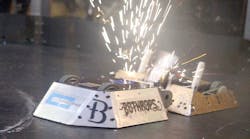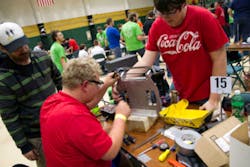You'd think Steve Staub's life would have changed drastically when he and his sister Sandy Keplinger were mentioned by name in Donald Trump's first State of the Union Address in 2018, touted as beneficiaries of his administration's recent sweeping tax reform. Their 20-year-old job shop in Dayton, Ohio, Staub Manufacturing Solutions, had just recorded its best year and was growing in floor space, employees and wages. It was a huge moment for the third-generation tool maker who started running milling machines at 14, but it hasn’t changed him.
Sure, the shout out in front of the entire nation by its most powerful person is bound to present drastically different opportunities. Staub attended a White House Christmas party, nabbed a board seat at the National Association of Manufacturers, testified before Congress on workforce issues, and privately discussed manufacturing strategy with Vice President Mike Pence and (outgoing) head of the Small Business Administration, Linda McMahon. That's a heckuva a lot to fit into fifteen months when you're running a manufacturing business. What he valued prior to the SOTU has not depreciated, though: keeping Americans interested in manufacturing jobs.
The Apathy Problem
Staub's fellow countrymen have not felt the same. Deloitte's most recent data predicts 2.4 million unfilled manufacturing jobs by 2028, citing a "misperception of manufacturing" as a key culprit. This apathy is nothing new to Staub
"I saw in the mid-80s, when I graduated high school, that people were not going into the industry," Staub says. "It was a big issue and it has only gotten worse."
Staub takes it upon himself to train about 60% of his workforce, (about 40 workers) at the facility from scratch. They become machinists, laser cutters and press brake operators, making metal parts for equipment manufacturers, the military and several other industries. One of these employees, welder Corey Adams, was also recognized bigly by the president in his address:
Corey is an all-American worker. He supported himself through high school, lost his job during the 2008 recession, and was later hired by Staub, where he trained to become a welder. Like many hardworking Americans, Corey plans to invest his tax‑cut raise into his new home and his two daughters’ education.
Adams' success is a prime example of why Americans should be beating down welding school doors, but they aren't. (Lincoln Electric CEO Chris Mapes addressed the problem quite succinctly at the Manufacturing & Technology Conference in 2018.)
Staub is quick to point out over the course of a lifetime, a welder can earn more than an attorney. Welders can start earning salaries several years sooner, due to nine months of schooling compared to six years or more. And factoring in virtually little to no student debt compared to $130,000-150,000 for undergrad and law school, the manufacturing story gets even more compelling. The kicker is there's no guarantee for a job after law school. In 2017, the pass rate for the Bar exam nationally was 59%, according to the National Conference of Bar Examiners.
That's not to say everyone should drop out of law school and pick up a welding torch, but when Staub advocates for manufacturing to school superintendents, "half of them have no idea" about how good a manufacturing job can be.
"Changing their mind is a slow process but we’re getting there," Staub says.
Shifting Perceptions
For about the last six years, Staub has chaired a Dayton-area hand-on program for students to ignite some interest in manufacturing, called Xtreme STEM.
"It's diverse to keep their attention and let them know what industry is about," Staub says.
There are a few different ways they have done this, from having kids 3D print blades for functional model wind turbines to making and racing drones. The biggest draw is the robot competition, with as many as 300 students competing.
On April 6, about 50 teams (75% for the high school-level Xtreme Bots and 25% for the Collegiate Clash) from throughout southern Ohio and nearby states will gather at Wright State University in Dayton to battle it out.
Staub says within the National Robotics League network, it's the second largest in the nation—behind the Pittsburgh area. And the students benefit greatly by working directly with manufacturers to build parts from scratch or recycled parts. A student preparing for a competition is also gaining the basic skills to succeed virtually anywhere in manufacturing, from design to programming to sales. Staub can’t track every student after leaving the program, but he does survey them while at the competitions, and says 65% plan to go to college for engineering or head straight to a factory.
He and a few other locals business stepped in when previous organizers were going to shut the program down.
"They thought it wasn't worth the time and energy to do it," Staub says. "A few of us volunteers said, 'No, you can’t do that.'"
Staub says the program is run on a shoestring budget and some manufacturers may spend a few hours a week with students and others an hour every other week. He says for parts and motors, the total cost is about $1,500, while the FIRST Robotics teams may cost several times more.
Dysinger, Inc., a machine shop near Staub, sponsors a team of about four students. Mandi White, Dysinger human resources specialist, says the 50-employee company often restocks its pool directly from these teams.
"The reason we're successful is we have a relationship with the guidance counselors and the teachers, who influence the students," says White, adding that they get parents and the community involved through plant visits.
Staub believes America is on the right path, as long as we figure out the opioid crisis, invest in infrastructure and sort out trade. Those are gigantic issues far beyond the purview of small manufacturers, but workforce is something they can put a dent into. And for what it's worth, the little free time Staub has to invest, he puts into these robotics clubs.
"Can you afford not to be part of it?" Staub asks.
For more info on starting or helping out an NRL team, visit www.gonrl.com.
About the Author
John Hitch
Senior Editor
John Hitch writes about the latest manufacturing trends and emerging technologies, including but not limited to: Robotics, the Industrial Internet of Things, 3D Printing, and Artificial Intelligence. He is a veteran of the United States Navy and former magazine freelancer based in Cleveland, Ohio.
Questions or comments may be directed to: [email protected]

